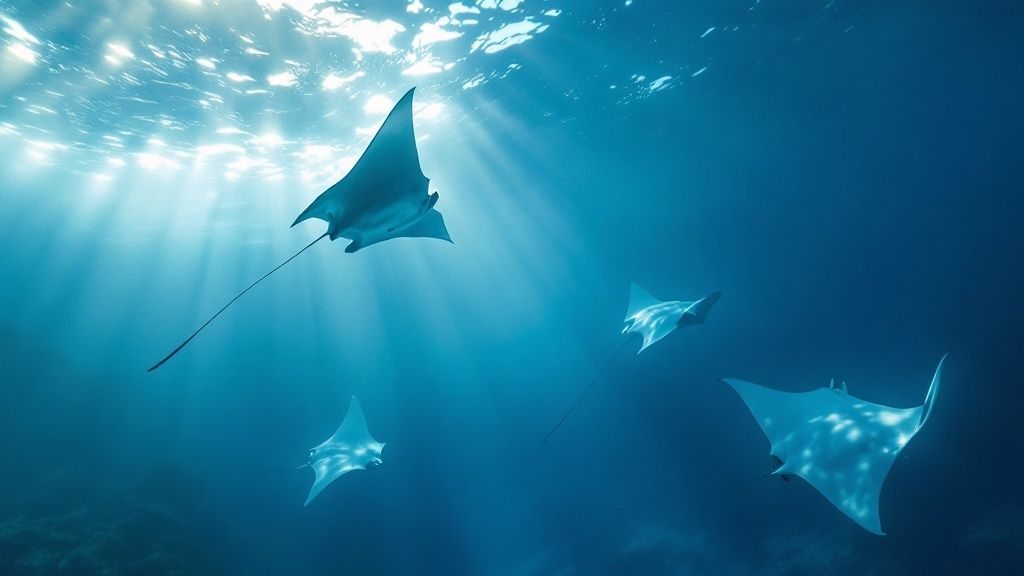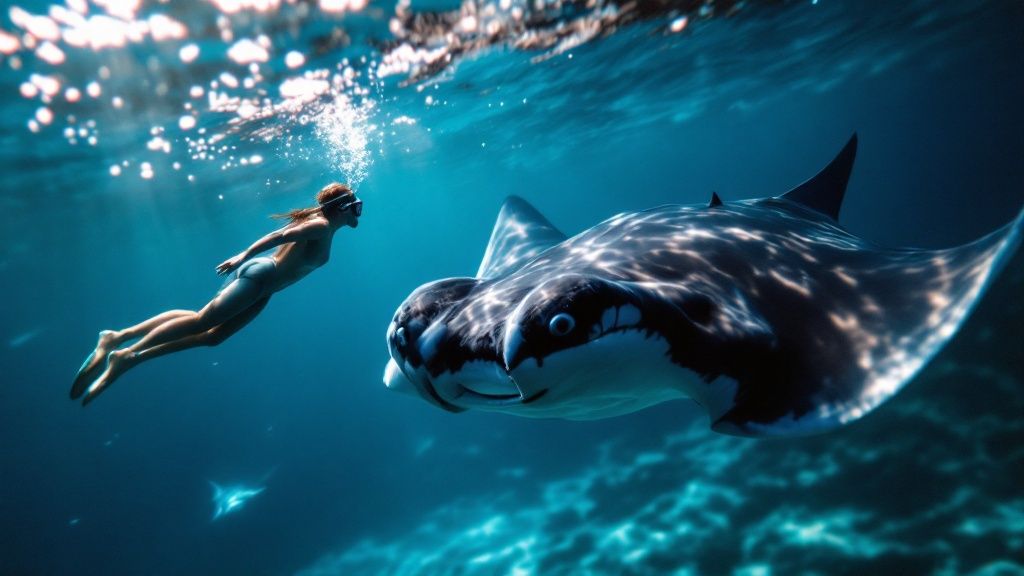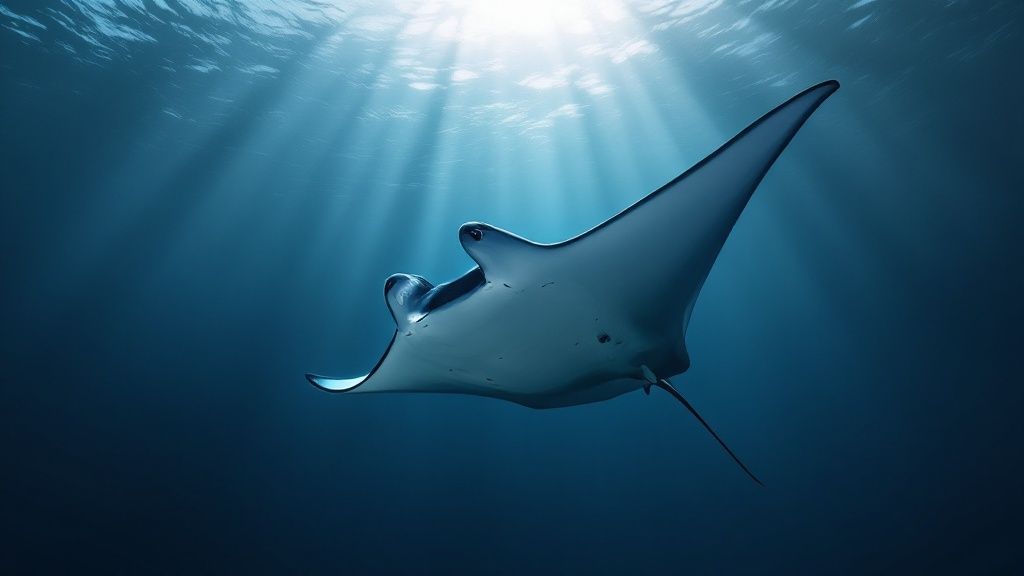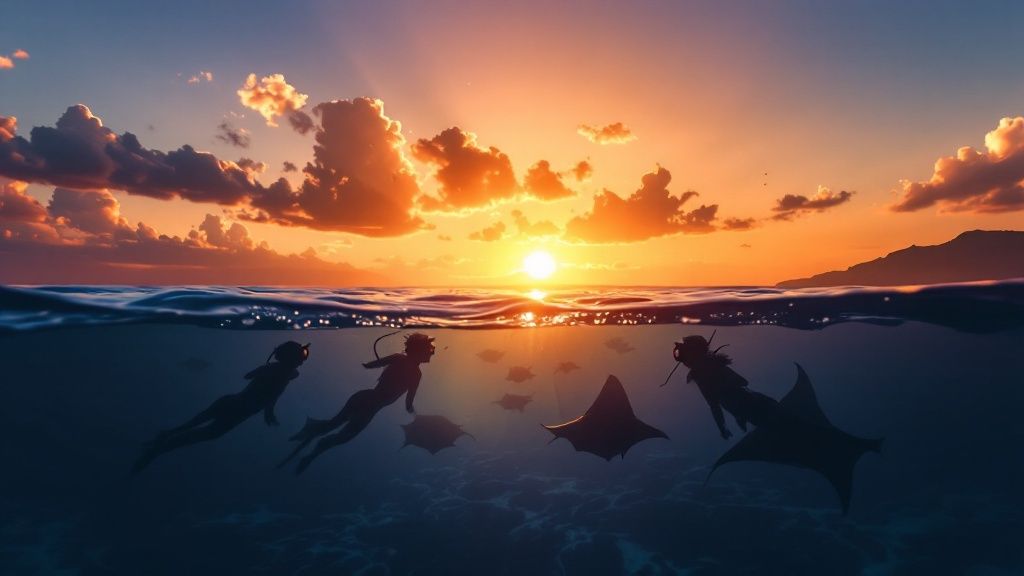Kona Manta Ray Snorkel: Unforgettable Night Dive

Why Kona Is the World's Premier Manta Ray Destination
Kona, Hawaii, is more than a tropical getaway; it's the place to encounter manta rays. What makes this Pacific locale so special? The answer lies in the volcanic formations below the surface. These underwater slopes and canyons, swept by nutrient-rich currents, create the perfect manta ray habitat.
This unique geography is key to attracting these gentle giants. The volcanic structures aren't just visually appealing; they're vital to the ecosystem. They support a rich supply of plankton, which is the manta ray's primary food source.
The currents swirling around these formations bring a constant flow of plankton. This creates a reliable feeding ground for the mantas. This predictable food source explains why Kona's manta rays are consistently present, offering a unique opportunity for snorkelers.
Kona's Remarkable Manta Ray Encounters
Kona's manta ray snorkeling boasts incredibly high success rates. Encounters happen between 80% and 90% of the time, year-round. Around 80,000 people experience this adventure annually, drawn by the consistent presence of these creatures. Find more detailed statistics here. This consistency sets Kona apart from other manta ray destinations, like the Maldives or Australia, where sightings are less reliable.
The Magic of the Experience
The experience itself is truly unforgettable. Kona's warm, clear waters offer fantastic visibility. This allows snorkelers to witness the graceful ballet of these magnificent creatures up close. Imagine a 12-foot manta ray, with a wingspan wider than you are tall, soaring effortlessly beneath you. It's a truly awe-inspiring spectacle.
A Sustainable Wonder
The Kona manta ray snorkel has evolved from a local secret into a must-do adventure, yet it retains its magic. Responsible tourism and a deep respect for these gentle giants ensure the experience remains sustainable. This approach helps preserve the ecosystem, letting visitors experience the wonder of Kona's manta rays in their natural habitat.

The Best Kona Manta Ray Snorkel Locations Revealed
Not all Kona manta ray snorkel locations offer the same experience. Each spot boasts unique characteristics, making research essential for a perfect snorkel adventure.
Manta Village: Up Close and Personal
Keauhou Bay, fondly called Manta Village, offers an intimate manta ray experience. The bay's calm, sheltered waters are ideal for beginners. This protected area also leads to frequent manta ray sightings. Plus, the short distance from shore minimizes boat travel time.
Manta Heaven: A Breathtaking Spectacle
For a truly awe-inspiring experience, head to Garden Eel Cove (Manta Heaven). Here, you'll witness spectacular displays of manta rays feeding in larger groups. Keep in mind that ocean conditions can be more unpredictable here, sometimes affecting visibility. This spot is generally better for experienced snorkelers.
Kona's manta ray snorkeling popularity stems from high sighting rates and unique experiences. Sheltered bays like Keauhou Bay (Manta Village) offer undisturbed feeding grounds for the manta rays. This, combined with the volcanic landscape and nutrient-rich waters, creates a thriving plankton population that sustains the mantas. The magic of night snorkeling under the moonlight, with 12-foot manta rays gracefully gliding below, enhances Kona's allure. Learn more about this amazing experience.
Unveiling Kona's Hidden Snorkeling Gems
While Manta Village and Manta Heaven are famous, Kona holds hidden gems. Some lesser-known spots offer secluded, personalized encounters. These might involve longer boat rides, but the reward can be a truly magical experience away from the crowds. For more tips, check out this resource: How to master your snorkel adventure.
Factors Influencing Visibility and Sightings
Seasonal changes and ocean conditions significantly impact visibility and manta ray sightings. Plankton blooms can reduce visibility at times, while other periods offer crystal-clear waters. Water temperature also fluctuates throughout the year. Understanding these factors is key to planning your adventure.
Choosing the Right Spot for Your Skill Level
Consider your experience when choosing a location. Beginners will appreciate Keauhou Bay's calmer waters. Experienced snorkelers and underwater photography enthusiasts might prefer the challenges and rewards of Garden Eel Cove or other open ocean locations.
To help you choose the perfect location, we've compiled a comparison table highlighting the key differences between the main manta ray snorkeling spots in Kona:
To help you choose the right spot for your adventure, we've put together a comparison table:
Kona Manta Ray Snorkel Locations Comparison
A comprehensive comparison of the main manta ray snorkeling locations in Kona, highlighting their unique features, success rates, and best times to visit
| Location | Success Rate | Best Time | Special Features | Avg. Water Conditions |
|---|---|---|---|---|
| Keauhou Bay (Manta Village) | High | Year-round | Calm waters, close to shore, ideal for beginners | Calm, clear |
| Garden Eel Cove (Manta Heaven) | High | Year-round | Larger manta ray gatherings, more challenging conditions | Variable, can be choppy |
| Other Kona Spots | Variable | Varies depending on location | Secluded experiences, fewer crowds, longer boat rides | Varies depending on location |
This table summarizes the key characteristics of each location, allowing you to easily compare and choose the best spot based on your preferences and experience level. Remember to factor in your comfort level in the water and your desire for a more intimate or spectacular encounter.

Ultimately, the best Kona manta ray snorkel location depends on your individual preferences. Whether you choose the intimacy of Manta Village or the spectacle of Manta Heaven, Kona promises an unforgettable encounter with these gentle giants.
The Night Dive Experience: From Shore to Spectacle

Your Kona manta ray snorkel adventure starts at the harbor. Excitement grows as you board the boat. The captain, a seasoned expert of the Kona coastline, carefully chooses the perfect viewing location based on the current conditions. This local knowledge maximizes your chances of a truly magical encounter.
Preparing For the Encounter
The trip to the snorkel site is short but important. During this time, the crew gives a thorough safety briefing and helps you get fitted with the necessary gear. Wetsuits are often suggested, as the water can be chilly at night. This prep ensures both your comfort and safety. You'll also get a floatation device, commonly a pool noodle, to help you stay buoyant and conserve energy in the water.
The "Plankton Soup" and the Arrival of the Mantas
Once you arrive, special lights are placed in the water. These lights aren't just for illumination; they attract plankton, creating what's called a "plankton soup." This feast is what brings the manta rays. The stage is set, and the magic starts. As the plankton accumulates, the manta rays appear. That initial sight of a manta emerging from the darkness is awe-inspiring.
An Underwater Ballet
With wingspans reaching up to 12 feet, these graceful giants move through the illuminated water, performing an underwater ballet. They execute elegant loops and barrel rolls as they dine on the plankton. It's a captivating spectacle. You'll be floating just above it all, giving you an immersive and memorable experience. The guides offer insights into the manta rays' feeding habits and social interactions, deepening your understanding of these incredible animals. For instance, you might see how they use their cephalic fins, those horn-like extensions on their heads, to direct plankton into their mouths.
Comfort and Visibility
While the manta rays are the main attraction, your comfort is a priority. Visibility in the water is typically excellent, offering clear views of the manta rays’ intricate movements. The generally calm waters of Kona enhance this clarity. Tour operators consistently report high success rates for manta ray sightings. Jack's Diving Locker, for example, boasts an 85-90% success rate, underscoring Kona's reputation as a prime manta ray snorkeling destination. Find more detailed statistics here. This reliability, coupled with a commitment to sustainable tourism, helps ensure the long-term preservation of this wonderful experience.
The Manta Ray Experience: A Memorable Conclusion
As your snorkel session ends, you'll return to the boat, full of awe and a newfound appreciation for these gentle giants. The entire experience, from the initial departure from the harbor to the last moments in the water, is designed to provide a safe, educational, and genuinely unforgettable Kona manta ray snorkel adventure.
Best Times for Your Kona Manta Ray Snorkel Adventure
Choosing the right time for your Kona manta ray snorkel can significantly enhance your experience. Different seasons offer varied water conditions, visibility, and even unique manta ray behaviors. Let's explore these factors so you can plan the perfect adventure.
Seasonal Variations and Manta Ray Behavior
Manta rays are present in Kona's waters year-round. However, certain periods offer distinct advantages. The dry season, from April to October, typically boasts calmer waters and improved visibility due to reduced rainfall and more tranquil ocean conditions. During the summer months (June through August), visibility often reaches its peak. Keep in mind, this is also the high season for tourism, meaning larger crowds and higher prices.
The shoulder seasons (April-May and September-October) offer a balance. You may encounter smaller crowds while still enjoying good weather and visibility. This translates to a more personal experience without sacrificing the quality of your manta ray encounter. Pricing can also be more budget-friendly during these months. If you have flexible travel dates, the shoulder seasons are worth considering.
Moon Phases and Plankton Blooms
Beyond seasonal patterns, other factors influence manta ray activity. Moon phases are particularly significant. The plankton that mantas feed on are drawn to light. Brighter nights, especially around the full moon, lead to increased plankton and more active manta rays. Interested in learning more? Check out How to master your Kona manta ray experience.
Seasonal plankton blooms, while a feast for mantas, can occasionally reduce visibility. This can make photography more challenging, although it creates a unique "plankton soup" effect. Consider this when planning, particularly if underwater photography is a priority. Proper gear is essential for a safe and enjoyable manta ray night dive. Here’s a helpful scuba diving checklist.

Booking Your Kona Manta Ray Adventure
When booking your Kona manta ray snorkel, booking at least two weeks in advance is recommended, especially during peak season. This helps secure your spot on your preferred tour and date. Many operators provide multiple time slots each evening, offering scheduling flexibility.
Pricing tends to fluctuate seasonally, with higher prices during peak season and lower prices during the shoulder and off-seasons. Compare pricing and potential discounts from various tour operators.
Be prepared for potential weather changes, even in the dry season. While Kona generally enjoys favorable weather, occasional rain or choppy seas can occur. Choosing a reputable tour operator with a flexible rescheduling policy is advisable.
To help you choose the best time for your snorkel adventure, let's take a closer look at the conditions throughout the year:
This table provides a monthly overview of the key factors impacting your manta ray snorkel experience. It helps you compare sighting probability, water temperature, visibility, crowd levels, and an overall rating for each month.
Seasonal Guide to Kona Manta Ray Snorkeling
| Month | Sighting Probability | Water Temperature | Visibility | Crowd Levels | Overall Rating |
|---|---|---|---|---|---|
| January | Moderate | Cooler | Good | Lower | Good |
| February | Moderate | Cooler | Good | Lower | Good |
| March | Moderate | Mild | Good | Increasing | Good |
| April | High | Mild | Very Good | Moderate | Excellent |
| May | High | Warming | Very Good | Moderate | Excellent |
| June | High | Warm | Excellent | High | Very Good |
| July | High | Warm | Excellent | High | Very Good |
| August | High | Warm | Excellent | High | Very Good |
| September | High | Warm | Very Good | Moderate | Excellent |
| October | High | Mild | Very Good | Moderate | Excellent |
| November | Moderate | Mild | Good | Lower | Good |
| December | Moderate | Cooler | Good | Lower | Good |
As you can see, the shoulder seasons (April-May and September-October) offer a compelling combination of high sighting probability, excellent visibility, and moderate crowd levels. While the summer months provide the best visibility, the higher crowds may detract from a more intimate experience. The winter months offer a quieter experience with good visibility, but the slightly cooler water temperatures may be a factor for some.
Choosing Your Ideal Time
The best time for your Kona manta ray snorkel ultimately depends on your priorities. Do you value smaller crowds and lower prices? Or is optimal visibility paramount? By understanding these seasonal variations, you can tailor your trip for an unforgettable manta ray experience.
Finding Your Perfect Kona Manta Ray Snorkel Tour
Planning a manta ray snorkel tour in Kona is exciting, but with so many options, it can quickly become overwhelming. This guide will break down the key factors to consider, helping you choose the perfect tour for an unforgettable experience.
Key Questions to Ask Before Booking
Before you commit to a tour, take a moment to ask these essential questions:
-
What is the boat capacity? A smaller boat creates a more intimate setting, perfect for those seeking a personalized experience. Larger boats, however, offer increased stability and may include amenities like restrooms.
-
What is the guide's experience? A knowledgeable guide can significantly enhance your trip, providing valuable insights about manta rays and ensuring your safety in the water.
-
What are the safety protocols? Thoroughly review the operator's safety measures and emergency preparedness plans for peace of mind.
-
What are their environmental practices? Opt for tour operators committed to sustainable tourism and manta ray conservation. Protecting these gentle giants and their habitat is crucial.
Boutique vs. Larger Operations: Finding Your Fit
Boutique tours typically cater to smaller groups, offering a highly personalized experience. This is ideal for those who prefer a more intimate and exclusive encounter with the manta rays. Larger operations, on the other hand, often offer more budget-friendly options and may provide amenities like snacks and drinks.
Families with young children might appreciate the stability and amenities of a larger boat. Couples, however, might find the intimate atmosphere of a boutique tour more romantic.
Deciphering Premium Pricing and Amenities
Some tours come with a higher price tag. It's important to understand what justifies these premium prices. Are they offering added value, like extended snorkel times, specialized guides, or high-quality GoPro equipment?
Consider which amenities genuinely enhance your experience. While hot showers, underwater photography packages, or light refreshments can be appealing, some might prefer a more basic, affordable tour.
Beyond the Reviews: Verifying Reputation
Don't rely solely on online reviews. Take the time to research the company's reputation and commitment to marine conservation. Look for partnerships with local organizations or involvement in research initiatives. Certifications or awards related to sustainable tourism practices are also good indicators. This extra step ensures you're choosing a responsible operator.
Family-Friendly Options and Non-Swimmer Accommodations
For families traveling with children, seek out family-friendly operators who cater to younger snorkelers and prioritize safety. Some tours also offer accommodations for non-swimmers, like viewing platforms or alternative activities, ensuring everyone can enjoy the magic of the manta rays.
Expert Advice for Decision-Making
Here are a few final tips to help you finalize your decision:
- Book early, especially during peak season. This helps secure your preferred date and time.
- Compare pricing from different operators. You might find discounts or special offers.
- Check for flexible rescheduling policies due to potential weather changes.
- Read detailed descriptions and reviews to understand exactly what each tour entails.
By carefully considering these points, you can confidently select the Kona manta ray snorkel tour that perfectly matches your needs and creates lasting memories.
Insider Tips for an Unforgettable Manta Ray Encounter
Elevating your Kona manta ray snorkel from memorable to extraordinary depends on understanding a few key details. These insights, gathered from experienced guides and marine enthusiasts, will help you maximize your encounter with these gentle giants.
Positioning for the Perfect View
Manta rays are attracted to the plankton that gathers around the lights used by tour operators. Positioning yourself correctly is crucial. Stay close to the light source, but not directly beneath it. This allows you to observe the mantas as they glide through the illuminated water. For example, hold onto the provided floatation devices and position yourself slightly away from the brightest point of light. This minimizes disturbance while offering optimal viewing angles as the mantas perform their feeding loops. You'll be able to witness their unique feeding behaviors without interfering.
Gear Up for Comfort and Clarity
The right gear dramatically improves comfort and visibility during your night snorkel. A wetsuit, even in Kona's warm waters, is recommended to combat the nighttime chill. A snug fit helps retain body heat, allowing you to focus on the manta rays. Also, apply anti-fog solution to your mask. This prevents fogging in the cooler night air and underwater, ensuring clear views. These preparations enhance your overall experience.
Capturing the Magic: Photography Tips
Even basic equipment can capture stunning manta ray photos. Use a high ISO setting and a fast shutter speed to compensate for low light. A red filter can enhance colors and reduce the blue cast common in underwater night photography. Position yourself for clear shots, anticipating the manta rays' movements. Remember to avoid using flash, which can disturb them. For instance, if a manta is performing a feeding loop, predict its path and position yourself accordingly.
Addressing Common Concerns
Concerns about seasickness, nighttime anxiety, and snorkel etiquette are common. For seasickness, consider taking ginger or motion sickness medication. You might be interested in: How to master your pre-snorkel preparation. If you're anxious about being in the water at night, talk to your guide. They are trained to provide support. Finally, remember proper snorkel etiquette: never touch the manta rays, maintain a respectful distance, and avoid sudden movements. This ensures both your safety and the well-being of the mantas.
Booking Your Unforgettable Adventure
Ready to experience the magic of Kona's manta rays? Book your snorkel tour today with Kona Snorkel Trips. Book your Kona Manta Ray Snorkel Adventure
